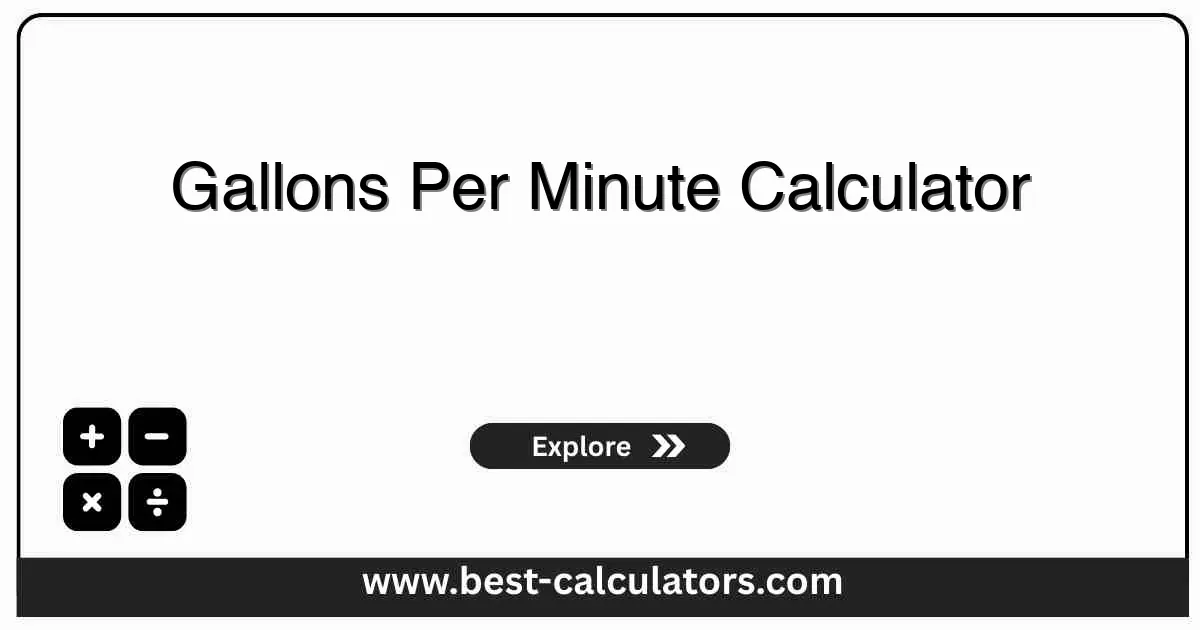Gallons Per Minute Calculator - Calculate Water Flow
Free GPM calculator to determine water flow rates for plumbing, irrigation, and sprinkler systems with accurate flow velocity and pipe capacity calculations
Gallons Per Minute Calculator
Results
What is a Gallons Per Minute Calculator?
A Gallons Per Minute (GPM) Calculator is a free construction tool that helps you calculate water flow rates for plumbing, irrigation, and sprinkler systems. It determines flow velocity, pipe capacity, and pressure requirements based on pipe dimensions and system characteristics.
This calculator works for:
- Plumbing systems - Determine flow rates for residential and commercial water supply
- Irrigation design - Calculate water delivery for sprinkler and drip systems
- Sprinkler systems - Size pipes and calculate coverage requirements
- Industrial processes - Determine flow rates for manufacturing and processing
- Pool and spa - Calculate circulation rates and equipment sizing
Related: For drainage system planning that involves water flow management, see our French Drain Calculator for comprehensive material and cost estimates.
How GPM Calculator Works
The calculation uses the fundamental water flow formulas:
Where:
- D = Pipe diameter in inches
- V = Flow velocity in feet per second
- π = Pi (3.14159)
- 144 = Conversion factor (in² to ft²)
Key Concepts Explained
Flow Velocity
Speed of water moving through pipes, typically 2-8 ft/s for optimal performance and minimal noise.
Pipe Capacity
Maximum flow rate a pipe can handle based on diameter, material, and pressure conditions.
How to Use This Calculator
Choose Method
Select calculation method based on available data
Enter Dimensions
Input pipe diameter, length, or volume data
Set Parameters
Add velocity, pressure, or time values
Benefits of Using This Calculator
- • Accurate Planning: Determine exact flow requirements for system design.
- • Cost Efficiency: Optimize pipe sizing to balance performance and material costs.
- • Code Compliance: Ensure designs meet plumbing and fire safety codes.
Factors That Affect Your Results
1. Pipe Material
Different materials (copper, PVC, steel) affect flow characteristics and friction loss.
2. System Pressure
Higher pressure increases flow rates but may require larger pipes to handle velocity.

Frequently Asked Questions (FAQ)
Q: How do I calculate gallons per minute from pipe diameter and velocity?
A: Use the formula: GPM = (π × diameter² ÷ 4) × velocity ÷ 144. For example, a 2-inch pipe with 5 ft/s velocity: GPM = (3.14 × 2² ÷ 4) × 5 ÷ 144 = 0.545 GPM.
Q: What is a typical residential water flow rate?
A: Typical residential water flow rates range from 6-12 GPM for most fixtures. Standard fixtures: bathroom faucets 0.5-2 GPM, showerheads 1.5-2.5 GPM, toilets 1.6-2.2 GPM.
Q: How do I size pipes for a given GPM requirement?
A: Calculate pipe diameter using: D = √(GPM × 144 ÷ (π × V)). Where D is diameter in inches, GPM is flow rate, and V is velocity (typically 2-8 ft/s for water systems).
Q: What factors affect water flow rate in pipes?
A: Key factors include pipe diameter, pipe length, material roughness, elevation changes, pressure, temperature, and fittings (elbows, valves, tees).
Q: How do I convert between GPM and other flow rate units?
A: Common conversions: 1 GPM = 0.227 cubic meters per hour, 1 GPM = 3.785 liters per minute, 1 GPM = 0.0631 liters per second.
Q: What is the optimal velocity for water in pipes?
A: Recommended water velocities: 2-4 ft/s for residential plumbing, 4-6 ft/s for commercial systems, 6-8 ft/s for industrial applications.